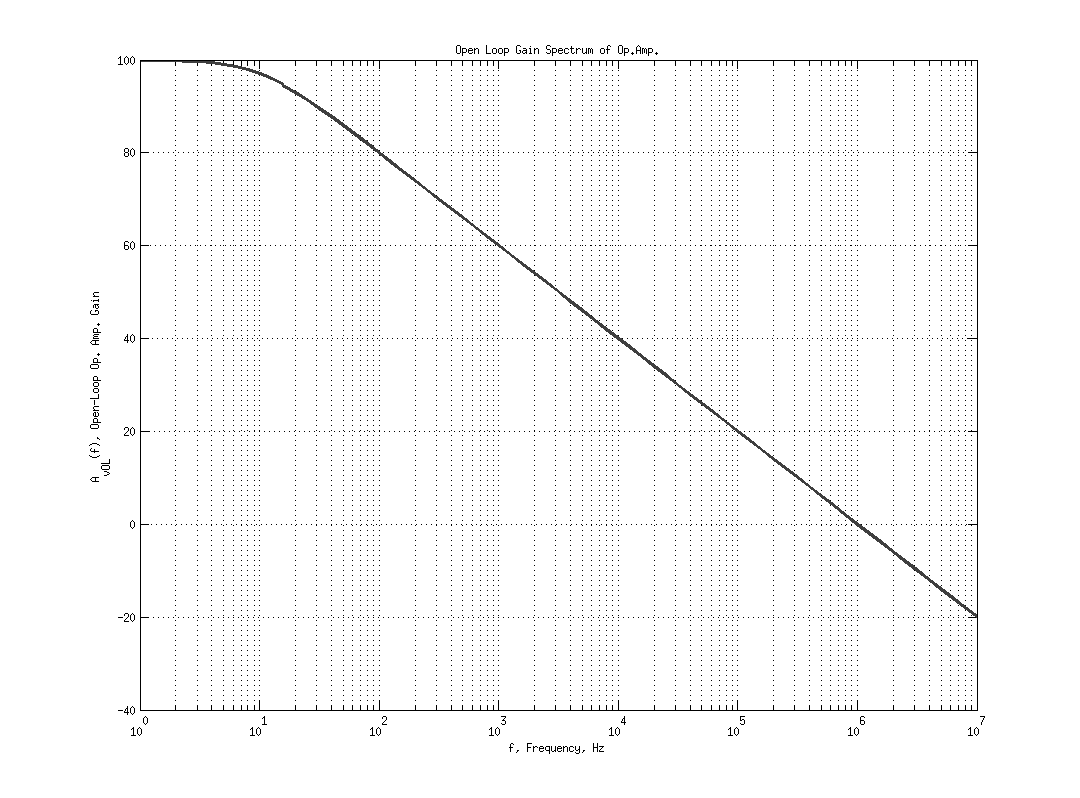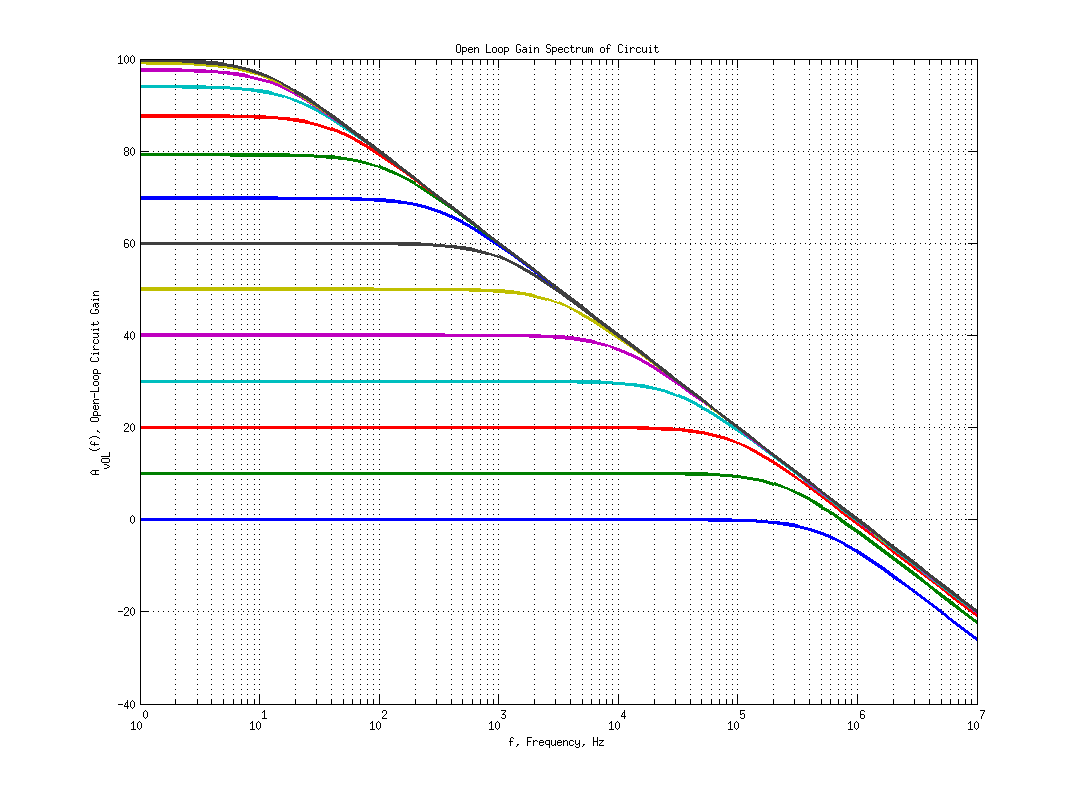Contents
- opamp.m Notes for Op Amp lectures
- Linear operation
- Inverting amplifier example
- Limit on input for 12-V supply
- Limit on input for 20 mA out of op amp
- Saturation Conditions
- An example of saturation with two signals
- Summing Junction with two signals
- Non-Ideal Op Amps: Finite Gain
- Lorentzian Spectrum and effects on sine waves.
- Non--Ideal Op Amp: Gain and Bandwidth
opamp.m Notes for Op Amp lectures
by Chuck DiMarzio Northeastern University September 2009 September 2016
Run at
moose=clock; runtime=[date,' at ',sprintf('%2.0f',moose(4)),':',sprintf('%02.0f',moose(5))] %
runtime = 17-Sep-2016 at 21:42
Linear operation

No current into or out of input terminals
Inverting amplifier example

R_1=1000;R_2=5000;R_L=500; A_v = -R_2/R_1 % Voltage gain A_vdB=20*log10(abs(A_v)) A_i=A_v^2*R_1/R_L % Current Gain A_idB=20*log10(abs(A_i)) A_p=A_v*A_i A_pdB=10*log10(abs(A_p)) % v_INdemo=[-4:0.1:4]; v_OUTdemo=v_INdemo*A_v; fig1=figure;plot(v_INdemo,v_OUTdemo); grid on; xlabel('v_{IN}, Input Voltage, Volts'); ylabel('v_{OUT}, Output Voltage, Volts'); title('Inverting Amplifier: Linear');
A_v =
-5
A_vdB =
13.9794
A_i =
50
A_idB =
33.9794
A_p =
-250
A_pdB =
23.9794
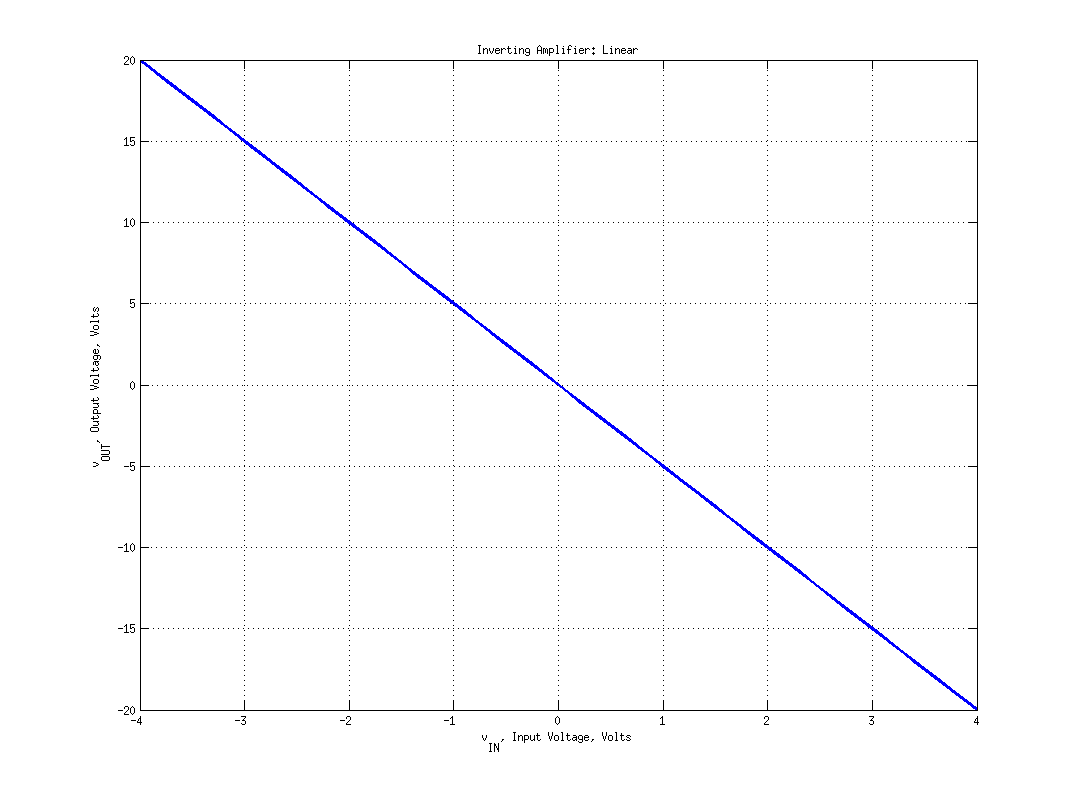
Limit on input for 12-V supply
disp('Limit on input for 12-V supply '); v_OUTvlimit=[-12,12] % Range of Voltages v_INvlimit=v_OUTvlimit./A_v
Limit on input for 12-V supply
v_OUTvlimit =
-12 12
v_INvlimit =
2.4000 -2.4000
Limit on input for 20 mA out of op amp
disp('Limit on input for 20 mA out of op amp'); i0=20e-3*[-1,1] % Output current in Amps r_par=1/(1/R_2+1/R_L) v_OUTilimit=i0*r_par % Voltage out at these currents v_INilimit=v_OUTilimit./A_v % Voltage in
Limit on input for 20 mA out of op amp
i0 =
-0.0200 0.0200
r_par =
454.5455
v_OUTilimit =
-9.0909 9.0909
v_INilimit =
1.8182 -1.8182
Saturation Conditions
Increase R_L or use a different op amp so that the current limit discussed above does not occur.

v_OUTp=v_OUTvlimit(2); % Output saturated to positive power supply rail v_OUTn=v_OUTvlimit(1); % Output saturated to negative power supply rail % First plot the output voltage as a piecewise linear % plot. First three lines show the individual pieces, and the last line % puts them together. The dots show the boundaries. % v_OUTwithsat=min(max(v_OUTdemo,-12),12); fig3=figure;plot(v_INdemo,v_OUTdemo,'--',... v_INdemo,v_OUTp*ones(size(v_INdemo)),'--',... v_INdemo,v_OUTn*ones(size(v_INdemo)),'--',... v_INdemo,v_OUTwithsat,'-',... v_INvlimit,v_OUTvlimit,'ko',... v_INilimit,v_OUTilimit,'kx'); grid on; xlabel('v_{IN}, Input Voltage, Volts'); ylabel('v_{OUT}, Output Voltage, Volts'); title('Inverting Amplifier: Transfer Characteristics'); % Then plot the voltage at the inverting input as a piecewise linear % plot. First three lines show the individual pieces, and the last line % puts them together. The dots show the boundaries. % v_minusp=v_INdemo+R_1/(R_2+R_1)*(v_OUTp-v_INdemo); % Voltage divider v_minusn=v_INdemo+R_1/(R_2+R_1)*(v_OUTn-v_INdemo); % Voltage divider fig2=figure;plot(v_INdemo,v_minusp,':',v_INdemo,v_minusn,'--',... v_INdemo,zeros(size(v_INdemo)),'-.',... v_INdemo,max(v_minusn,min(0,v_minusp)),'-',... v_INvlimit,zeros(size(v_INvlimit)),'ko'); grid on; xlabel('v_{IN}, Input Voltage, Volts'); ylabel('v_{-}, Volts'); title('Inverting Amplifier Saturation'); legend('Pos Saturation, V_-<V_+',... 'Neg Saturation, V_+<V_-',... 'Linear Operation','Location','NorthWest');
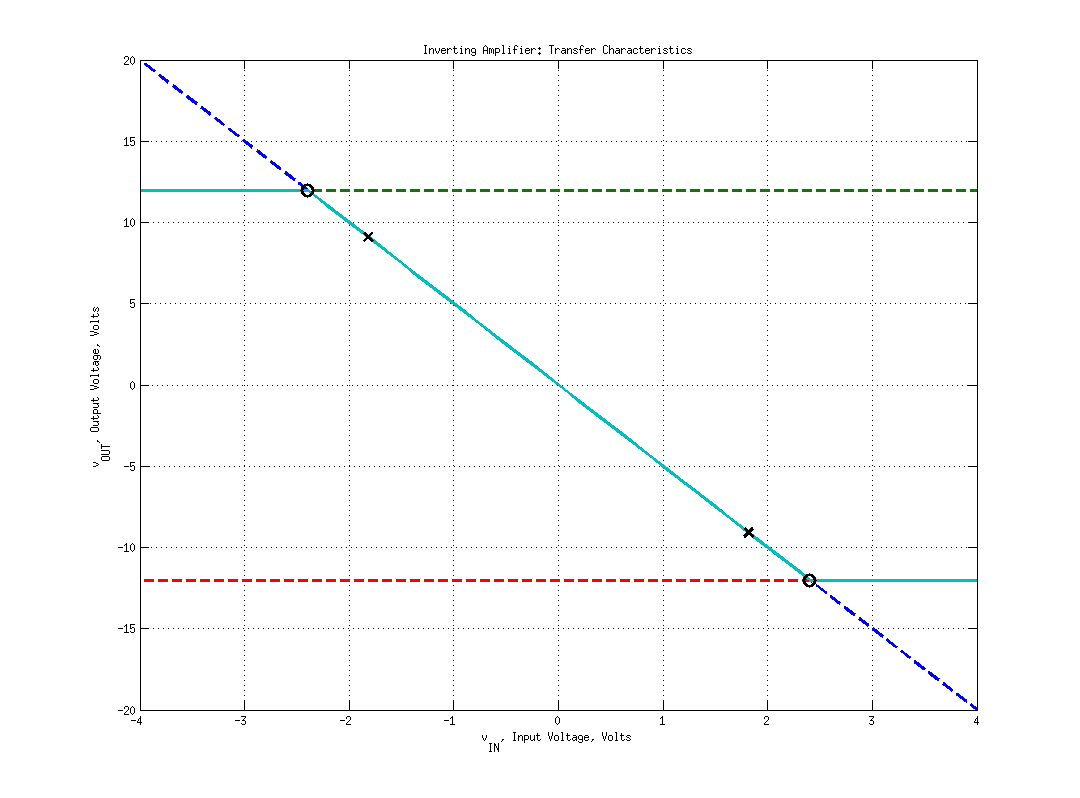
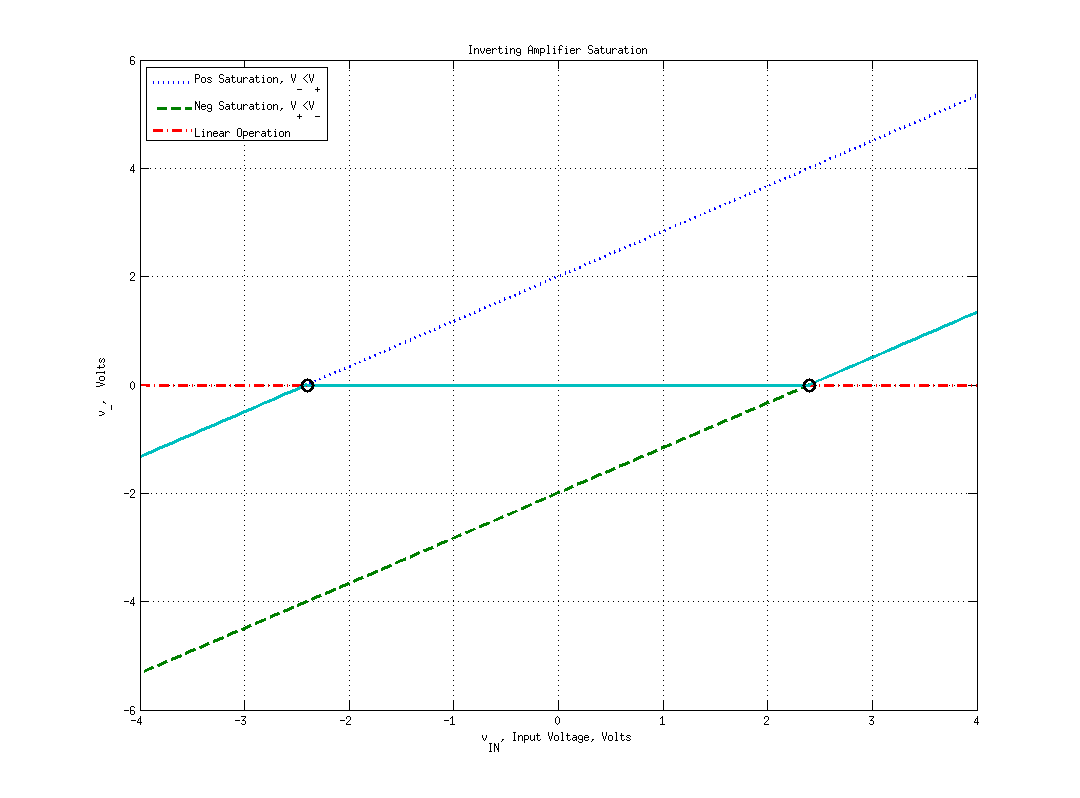
An example of saturation with two signals
t=[0:0.02:40]*1e-3; % Time to 40 msec f_a=750; V_apk=5;v_A=V_apk*sin(2*pi*f_a*t); % Signals a and b at f_b=75;V_bpk=1.0;v_B=V_bpk*sin(2*pi*f_b*t); % two different frequencies v_IN=v_A+v_B; % Add them v_OUT=min(max(-(R_2/R_1*v_IN),v_OUTn),v_OUTp);% Output including saturation fig4=figure;plot(t*1000,v_IN,t*1000,v_OUT); xlabel('t, Time, msec'); ylabel('Input and Output, Volts'); title('Saturation Example');
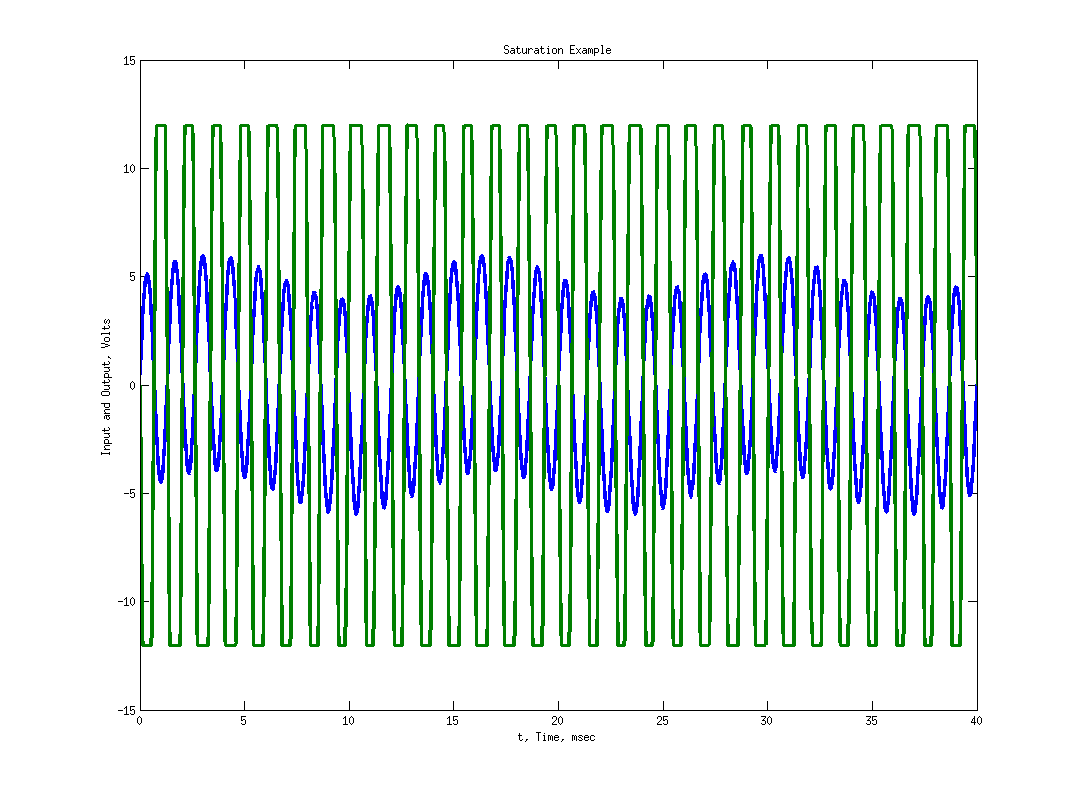
Summing Junction with two signals
R_1a=1000;R_1b=500; f_a=12; V_apk=1;v_A=V_apk*sin(2*pi*f_a*t); f_b=500;V_bpk=0.5;v_B=V_bpk*sin(2*pi*f_b*t); v_OUT=min(max(-(R_2/R_1a*v_A+R_2/R_1b*v_B),v_OUTn),v_OUTp); fig5=figure;plot(t*1000,v_A,t*1000,v_B,t*1000,v_OUT); xlabel('t, Time, msec'); ylabel('Input and Output, Volts'); title('Summing Junction Output');
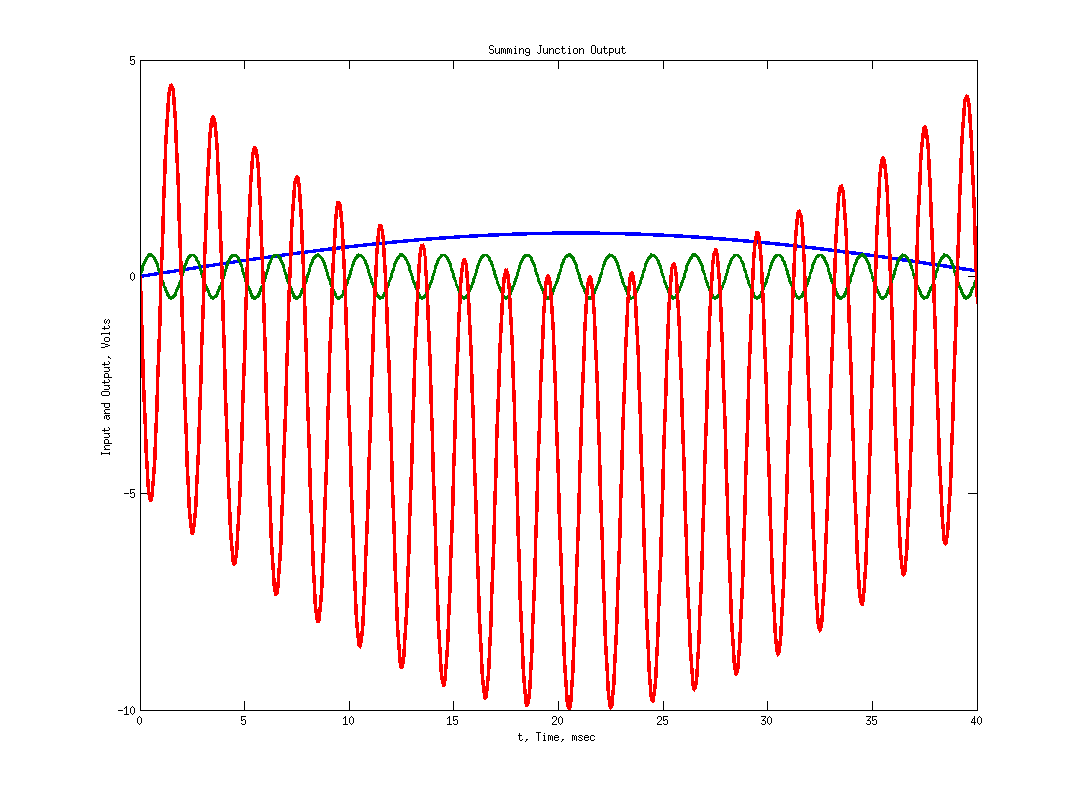
Non-Ideal Op Amps: Finite Gain

targetgaindB=[0:100]; % Our desired gain in dB targetgain=10.^(targetgaindB/20); % R_2/R_1 A_OL=1e5; A_vOL=-targetgain.*A_OL./(A_OL+targetgain+1); actualgaindB=20*log10(abs(A_vOL)); % Remember the abs because voltage gain is % negative A_OL=1e5; A_vOL=-targetgain.*A_OL./(A_OL+targetgain+1); actualgaindB1e5=20*log10(abs(A_vOL)); % Give the output a different name A_OL=1e3; A_vOL=-targetgain.*A_OL./(A_OL+targetgain+1); actualgaindB1e3=20*log10(abs(A_vOL)); fig6=figure;plot(targetgaindB,actualgaindB1e5,'b-',... targetgaindB,actualgaindB1e3,'g--');grid on; xlabel('R_2/R_1, Target Gain, dB'); ylabel('A_{vOL}, Open Loop Gain, dB'); title('Saturation of Gain'); legend('A_{OL}=10^5','A_{OL}=10^3','Location','NorthWest');
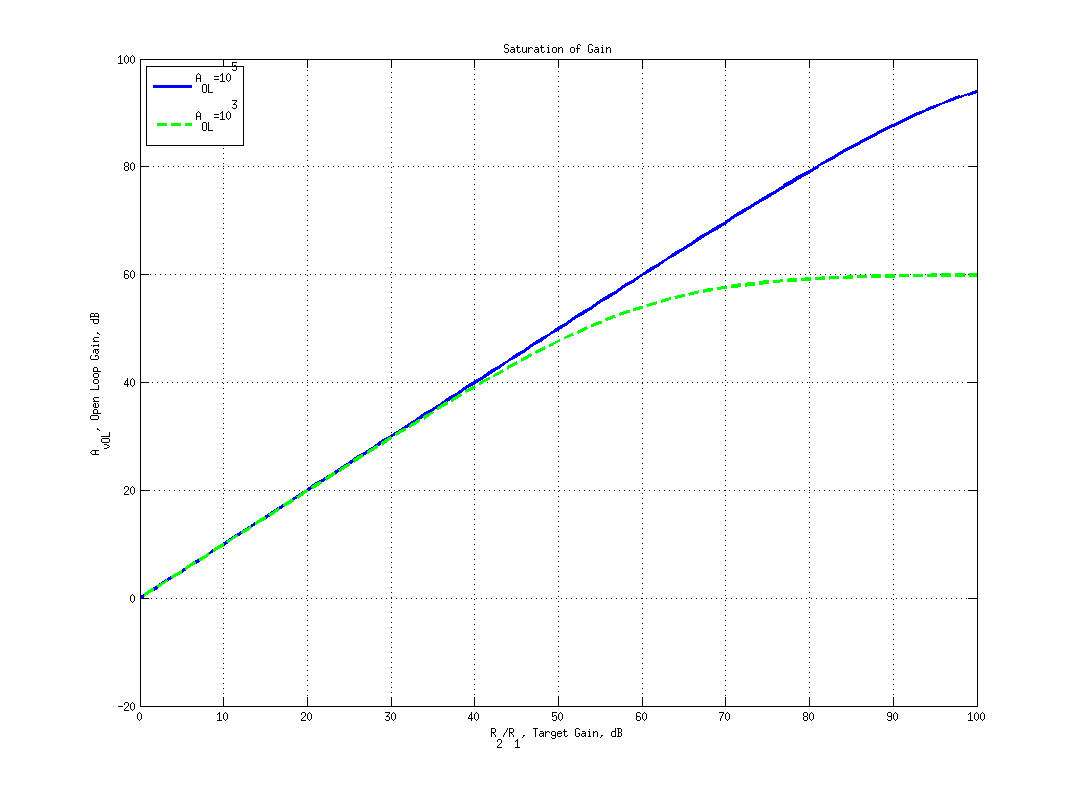
Lorentzian Spectrum and effects on sine waves.

A_v0=5; % Gain at zero frequency fb=1e6; % Bandwidth % Plot the spectra of amplitude and phase f=10.^[4:0.1:8]; % A_v=A_v0./(1+j*f/fb); fig8=figure; subplot(2,1,1);semilogx(f,abs(A_v).^2,'-',fb,abs(A_v0)^2/2,'o');grid on; ylabel('A_v^2, Power Gain'); subplot(2,1,2);semilogx(f,180/pi*angle(A_v),'-',fb,-45,'o');grid on; moose=axis;axis([moose(1:2),-90,0]); xlabel('f, Frequency, Hz'); ylabel('Phase, deg'); % Now show some examples at specific frequencies % % freqlist=[1e5,7e5,2e6,1e7];% operating frequencies fig9=figure; for n=1:4; f=freqlist(n); A_v=A_v0/(1+j*f/fb); % % Plot time history for a couple cycles t=[0:0.01:1]*2/f; v_IN=exp(j*2*pi*f*t); v_OUT=v_IN*A_v; subplot(2,2,n); plot(t,real(v_IN),'-',t,real(v_OUT),'--');grid on; if f<1e6; % Write the frequency on the plot text(t(12),4,['f = ',sprintf('%0.0f',f/1e3),' kHz']); else; text(t(12),4,['f = ',sprintf('%0.0f',f/1e6),' MHz']); end; text(t(12),2.5,['f_b = ',sprintf('%0.0f',fb/1e6),' MHz']); axis([t(1),t(end),-5,5]); % Fix the axes xlabel('t, Time, sec'); ylabel('Voltage'); end; %
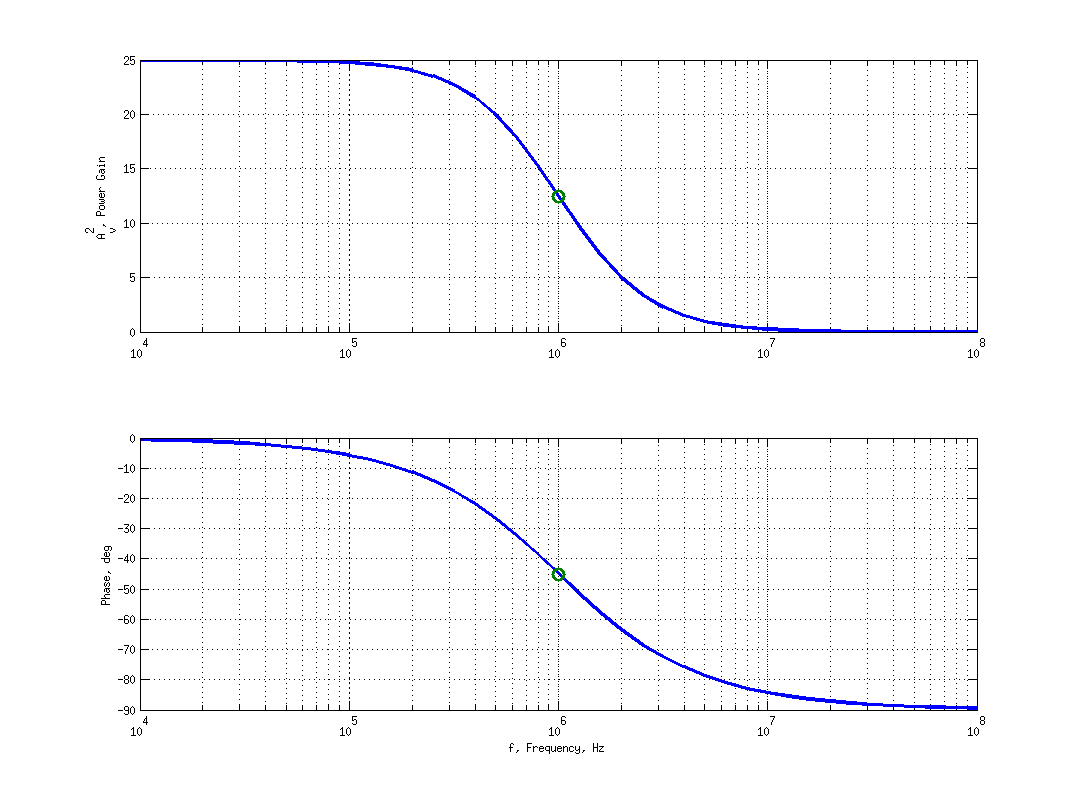
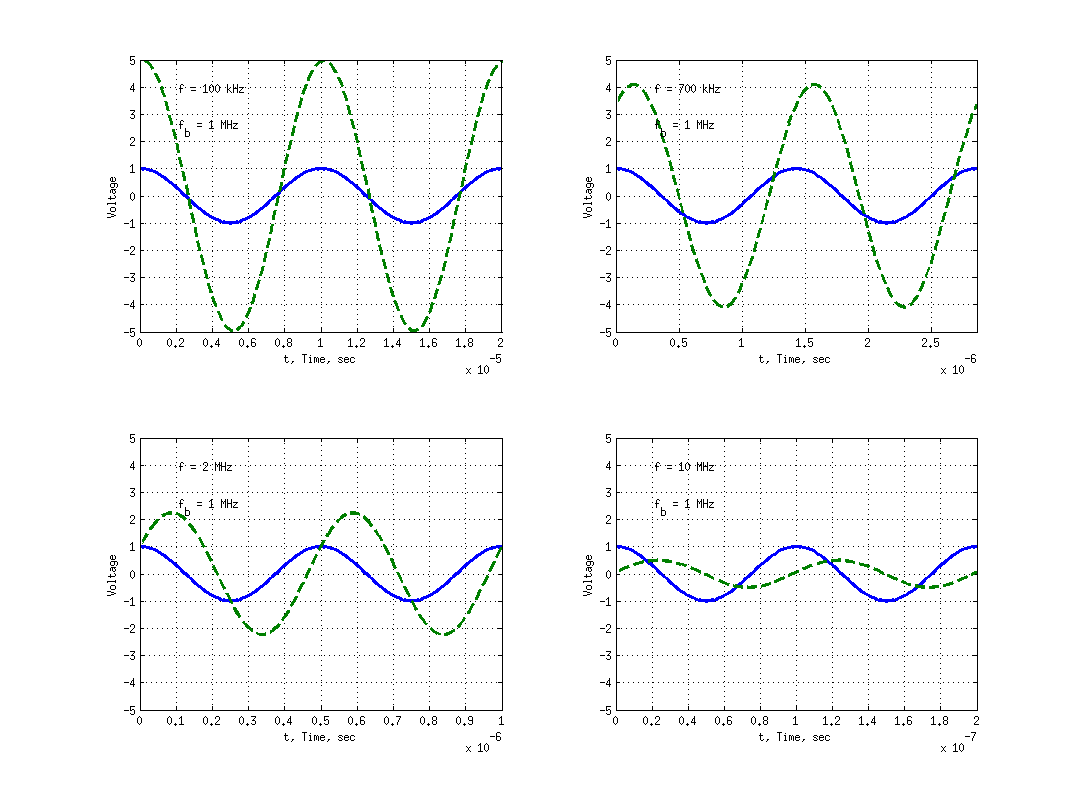
Non--Ideal Op Amp: Gain and Bandwidth
faxis=10.^[0:0.1:7]; % Frequency axis for spectrum targetgainaxis=10.^([0:10:130]/20); % Several gains [targetgain,f]=meshgrid(targetgainaxis,faxis); % Make these 2-D arrays A_0OL=1e5; f_BOL=1e6/A_0OL A_OL=A_0OL./(1+j*f/f_BOL); fig7=figure;semilogx(f,20*log10(abs(A_OL)));grid on; xlabel('f, Frequency, Hz'); ylabel('A_{vOL}(f), Open-Loop Op. Amp. Gain'); title('Open Loop Gain Spectrum of Op.Amp.'); % Use the Op Amp in a circuit A_vOL=-targetgain./(1+(targetgain+1)./A_0OL.*(1+j*f/f_BOL)); fig7=figure;semilogx(f,20*log10(abs(A_vOL)));grid on; xlabel('f, Frequency, Hz'); ylabel('A_{vOL}(f), Open-Loop Circuit Gain'); title('Open Loop Gain Spectrum of Circuit');
f_BOL =
10
